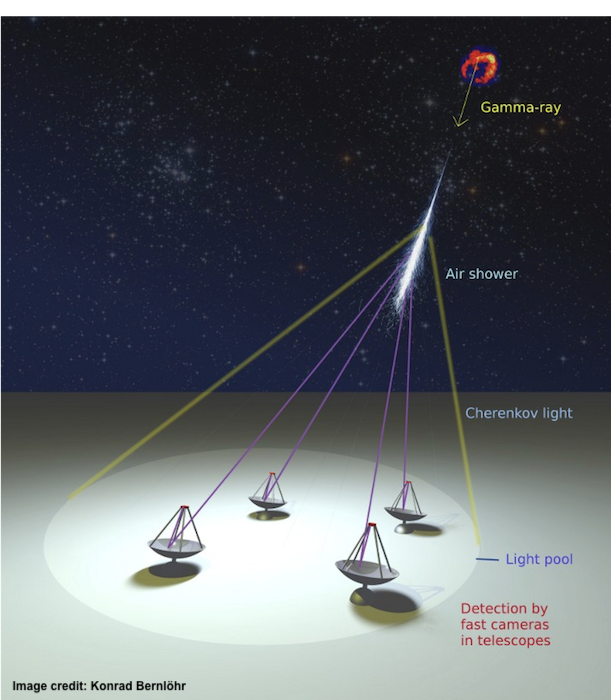High Energy Stereoscopic System

The High Energy Stereoscopic System, or H.E.S.S. for short, is an array of five gamma-ray telescopes located in the Khomas Highland of Namibia. Although it is in operation since 20 years, it is to this date the only very-high-energy gamma-ray detector operated on the Southern Hemisphere (where “very high energy” means higher than about 100 Giga-electronvolt, or GeV). As the inner Milky Way is visible best on the Southern Sky, this makes it an ideal instrument for the study of Galactic gamma-ray sources - my prime research interest.

The highest-energy gamma rays are so rare that they cannot be observed directly with a space-based telescope - the chances to detect enough of them are simply too slim. Instead, one needs to detect them indirectly from the ground, by measuring the particle shower that they launch when they hit Earth’s atmosphere. One way of doing this is to use telescopes that observe the Cherenkov radiation emitted by particles in the shower - a few-nano-second-short blue-ish light flash. From this, the properties of the primary gamma ray - in particular its incoming direction and its energy - can be inferred. This detection principle is illustrated in the image on the right. Because the Cherenkov light flash is very faint, it works well only in places with a clear atmosphere and dark nights.
Initially, the H.E.S.S. array consisted of only four telescopes - the “small” ones in the image at the top - which have a mirror diameter of 12 metres (so are really not that small!). These four telescopes started measuring at the end of 2003, and have yielded some spectacular results: the first detection of very-high-energy gamma rays from a supernova remnant, an extremely bright outburst of a blazar, and a survey of the Galactic plane that has revealed a wealth of new very-high-energy gamma ray sources (among many others).
In 2012, the array was completed with a fifth telescope, placed in the centre, with a staggering mirror diameter of 28 metres (see again the image above). With its huge mirror, it can detect fainter light flashes, that means, lower-energy gamma rays. This has enabled - again, among many other results - the detection of pulsed gamma-ray emission from the Vela pulsar down to energies of 20 GeV.
Some more recent highlights achieved with H.E.S.S. include the detection of afterglow emission from a gamma-ray burst, the discovery of very-high-energy gamma-ray emission from a Nova, and a study of the Galactic microquasar SS 433. Recent results I have been deeply involved in are a detailed study of the gamma-ray emission from the star cluster Westerlund 1 and a measurement of the spectrum and extension of the Crab Nebula in the gamma-ray domain.
Besides being involved in many data analysis projects, I led from 2019–2025 a working group in the H.E.S.S. Collaboration that is responsible for the development of one of the H.E.S.S. data analysis chains. Since October 2025, I serve as director and spokesperson of the H.E.S.S. Collaboration.
Further information:
H.E.S.S. image credit: H.E.S.S. Collaboration.
